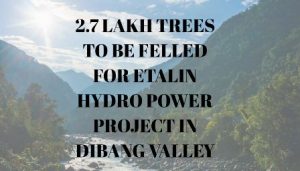Dibang River Power Project: Biggest Project, Maximum Concerns
Dibang Valley, being located in seismic zone, has high possibility of dam failure. If any natural calamity struck the area, itwill create havoc for the people living in downstream.
 On 12 May 2020, a gathering of 291 researchers and unified conservation experts wrote to Prakash Javadekar, Union Environment Minister, about the manner on how the forest and environment clearances were conceded across India during lockdown. Their letter requested the ministry to do its intending work, “which is the protection of India’s forest, wildlife and natural heritage and not fast track leeway of clearance projects”. During the lockdown, more than 30 proposed projects were cleared or discussed over video call conference, despite opposition.
On 12 May 2020, a gathering of 291 researchers and unified conservation experts wrote to Prakash Javadekar, Union Environment Minister, about the manner on how the forest and environment clearances were conceded across India during lockdown. Their letter requested the ministry to do its intending work, “which is the protection of India’s forest, wildlife and natural heritage and not fast track leeway of clearance projects”. During the lockdown, more than 30 proposed projects were cleared or discussed over video call conference, despite opposition.
On 23 April 2020, in a virtual meeting by the Forest Advisory Committee (FAC), the Etalin Hydroelectric Project in Dibang Valley of Arunachal Pradesh was also discussed. As a result, FAC’s office was flooded with e-mails flagging the gigantic biodiversity loss by many wildlife biologists, scientists, researchers, concerned citizens and organisations from around the country. The project requires diversion of 1155.1 hectare of biodiversity rich community forestland, felling of 200,000 trees, putting at risk up to 555 species of birds, 60 species of mammals, 48 species of amphibians and 381 species of butterflies and several others in this rich biodiversity. Wildlife scientists Umesh Srinivasan and Dr Nandini Velho wrote to FAC highlighting the presence of tiger, six colour variations of Asian golden cat (highest in the world) and eight individual clouded leopards at various locations of Dibang Valley. Conservation India, a non-profit website on wildlife and native conservation, sent a memorandum with 4305 signatures, which were received in three days, to the ministry asking to deny environmental clearance of the project, the portal said.
Also Read : Baghjan Oil Leak and Blowout: Questions Remain
The 3097 MW Etalin hydroelectric project in Dibang River will generate 2880 MW power and is believed to be India’s largest hydroelectric project and the world’s tallest concrete gravity dam at 278 metre above sea level. Both the proposed 3097 MW Etalin project and the approved Dibang multipurpose project have been planned on the same limb of the river and will together turnout in the devastation of a major lump of Dibang Valley. It will result in displacement of over 100 families from their homes and over 700 families lose their lands, affecting the cultural diversity of Indigenous tribes (Idu Mishmi) reside over the proposed project areas.
Independent researcher and geographer, Chintan Seth, wrote to FAC warning about the natural hazard risk in Dibang Valley.
Dibang stream is situated in high mountain watershed, the mountains upstream contain 300 glaciers and 350 glacial lakes that feed the stream.
However, because of environmental change the glaciers have thinned with a prediction of loss of further 60 per cent of their present volume by 2050, this offers ascend to unnatural arrangement of lakes on surface, which causes abrupt flood.
Additionally, it is located in a seismically active zone with 34 earthquakes reported in past century; most of them had their epicentre in the immediate vicinity of the Etalin village. If the dam breaches due to earthquake, it will have an immediate effect in the downstream areas like Assam.
Construction of dams host public health-related consequences with many water-borne diseases like Cholera, Malaria and Dengue. Dibang Valley is remotely situated, and hunting practices and consumption of wild animals may tend to increase as more people are brought in as labourers, which can result in another pandemic. Jorjo tana Tara, a conservation activist based in Arunachal told Arunachal Mirror, “Destroying rainforest will bring out 300 different types of virus which can also lead to a pandemic in future”.
 The Etalin project was halted for six years; it was rejected twice previously by the environment ministry’s FAC on account of environmental and social concerns. In the first rejection, FAC noted that “Ecological, environmental and social costs of diversion of such vast part of forest land, which is a major source of livelihood of the tribal population of the state, will outweigh the benefits likely to be acquired from the project”. In the second rejection, the FAC said that “the area had a large number of endemic and endangered flora and fauna”. However, on 28 February 2017, FAC met again to discuss granting of forest clearance and recommended, “a multiple season replicate study of Biodiversity assessment of the catchment area”. The Wildlife Institute of India accordingly produced a technical report, which was reviewed by 24 scientists from 14 scientific institutions in India, andthey affirmed that the report doesn’t reflect the true picture of the biodiversity of the area. While it was asked to do a multiple season study. The study was conducted only between February and June 2018.
The Etalin project was halted for six years; it was rejected twice previously by the environment ministry’s FAC on account of environmental and social concerns. In the first rejection, FAC noted that “Ecological, environmental and social costs of diversion of such vast part of forest land, which is a major source of livelihood of the tribal population of the state, will outweigh the benefits likely to be acquired from the project”. In the second rejection, the FAC said that “the area had a large number of endemic and endangered flora and fauna”. However, on 28 February 2017, FAC met again to discuss granting of forest clearance and recommended, “a multiple season replicate study of Biodiversity assessment of the catchment area”. The Wildlife Institute of India accordingly produced a technical report, which was reviewed by 24 scientists from 14 scientific institutions in India, andthey affirmed that the report doesn’t reflect the true picture of the biodiversity of the area. While it was asked to do a multiple season study. The study was conducted only between February and June 2018.
Government’s Rationale
India has hydropower potential of 145,320 MW of which only 45,400 MW is utilised so far. The projects in Dibang Valley will be strong, based on hydroelectric power, with flood moderation as key objective. It will prevent flood in downstream flood-prone areas like Assam, but Dibang Valley, located in seismic zone, has high possibility of dam failure. If any natural calamity struck the area, it will create havoc for the people living in downstream.
The project has proposed to invest Rs 2.42 bn on community and social development addressing concerns raised by the local community during the public hearing. The Idu Mishmi tribe had protested against the dam in the past, and they were somehow shut down by the state and forced to accept the compensation. Now, the views are conflicting because Dibang Valley is located in a remote area with the coming of this promising hydroelectric project the villagers can expect some development. Moreover, the Ministry is also taking steps to avail easy environmental clearance to such developmental projects.
Dam Safety Bill 2019
On 29 July 2019, a bill to provide surveillance, inspection, operation and maintenance for all dams with the height of more than 15 metre or between 10 and 15 metre around the country. The bill provides for the establishment of a National Dam Safety Regulatory Authority to implement the policy, guidelines and standards for dam safety.
There were around 36 dam failures in states like Rajasthan, Madhya Pradesh, Gujarat, etc.
The bill was criticised by the Opposition Parties for several reasons. The Biju Janata Dal’s B.Mahtab accused the bill as the Centre’s attempt to appropriate the powers of the state, while the Trinamool Congress member Saugata Roy also questioned the parliament’s power to enact such a law since water resource is a part of the State List.
Also Read : Rising number of environmental refugees in the world
Environmental Impact Assessment, 2020
Another step taken by the state to push such projects is the newly proposed Environment Impact Assessment (EIA) draft 2020. It was introduced for more transparency and expediency by initiating an online system, further delegation, rationalisation and standardisation of the process. This comes with a great criticism from the activists because it completely dilutes the principles of EIA notification 2006.Its emphasis on ‘Post facto’ approval of the project, which means that the clearance of the project can be carried out if they have started construction or have been in running phase without environment clearance. Post facto is a violation of environmental jurisprudence, and it is also infringement of ‘precautionary principles’, which is a principle of sustainable development. The bill has also proposed to reduce the timing of public hearing from 30 days to 20 days and complete exemption of public hearing in certain instances. If adequate time is not given for the preparation of views and comments and to those who will be affected then such public hearings will not be meaningful at all and to exempt public hearing in some projects that can have an impact on the environment is a complete shutdown of voices of those who are affected. The 2020 draft offers no solution for the political and bureaucratic fortification on the EIA procedure, and in this way on enterprises. Rather, it proposes to reinforce the administration’s optional force, while restricting open commitment in safeguarding the environment.
If the new EIA 2020 is passed, it will result in easy passing of environmental clearance to high-risk projects like Dibang Valley hydroelectric project, and many more in future. It will lead to devastation of uncountable lives and destruction of environment; the way state is in hurry to push such developmental projects may cost us more than what we can imagine. The draft is up for public consideration, and earlier the Union Environment Minister Prakash Javadekar set the new deadline on 30 June for 20 days, this didn’t come very pleasant with the environmentalists,and they moved to the courts, and the Delhi High Court had extended the date to 11 August for duration of 60 days.
